by
Evan Norris
, posted 4 hours ago / 345 Views
Reviewer's Note: Shujinkou was reviewed on a Switch 2.
For the longest time, I've wanted to learn to read Japanese. I suspect that most video game enthusiasts who didn't grow up in a Japanese-speaking household, at some point in their lives, have felt the same. So much of what we love about the medium has come directly from Japanese studios, creators, and auteurs. And more than a few acclaimed games are available only in Japanese, ambitious fan translations notwithstanding. So, the arrival this year of Shujinkou, a role-playing dungeon-crawler that teaches you Japanese as you enjoy its story, mechanics, and systems, is reason for celebration. What better way to learn a new language than by doing it side-by-side with something you love?
Shujinkou takes place in a fantasy version of feudal Japan. For an age, the land's six nations lived side-by-side in harmony. However, a darkness is now creeping into the world. Demonic beings have started to attack humans, either killing them outright or leaving them alive, stripped of their ability to communicate in Japanese. The tale begins in earnest in Himamura, a small, tranquil village on Genya, an island in the southeastern corner of the world. One fateful day, a stray demon enters the town, slays an innocent citizen, and destroys the fragile peace in Himamura. Soon after, the local samurai, Shu, assembles a team of friends to investigate the disturbance. What he finds is far more insidious than expected.

The story in Shujinkou is quite good, if a little parochial. Shu and his party travel across Genya, searching for clues, helping needy townspeople, and slowly moving toward the source of the conspiracy. But the central plot hook turns out to be less important than all the character-building and camaraderie that surrounds it. This is where the game truly shines. Developer Julian Rice, who more or less made Shujinkou himself, clearly wanted his characters to feel real and grounded, and connected with one another. Before Shu even sets foot outside of Himamura, we meet his kid sister Momo, older brother Daisuke, and best friends Shirouto and Toushiro.
Rice takes his time to introduce these characters, explain the familial and community ties that bind them together, and introduce many opportunities for them to chat, vent, confess, and rib each other. Shu is the leader, but he wouldn't be who he is without the bookish Shirouto or the impulsive Toushiro, also known as “the most optimistic beefhead in the world.” Then there's Jin, who joins the party around 20 hours in. He quickly became my favorite, due to his childlike wonder at the vastness of the world and the enormity of the Japanese syllabary, and his Drax-like inclination to take everything too literally. There's also Kou, although she's introduced too late in the game to leave a deep impression.
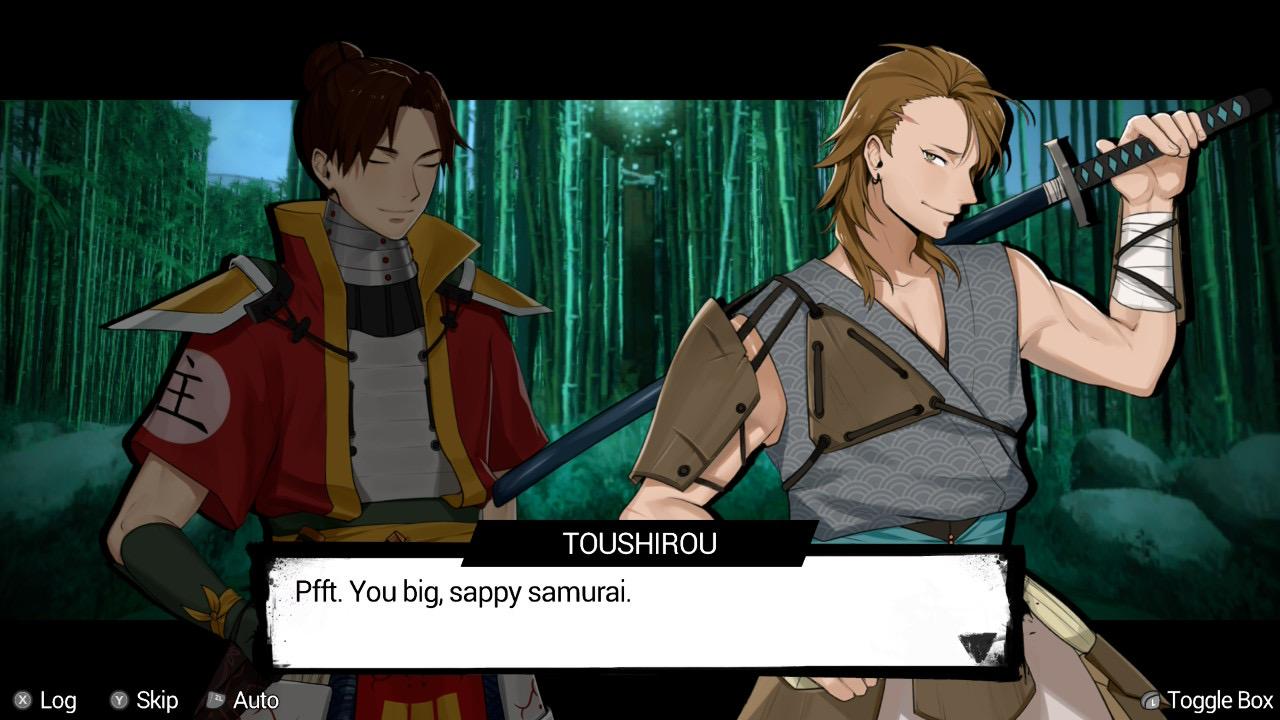
It helps, too, that so many supporting characters travel with the adventuring party to towns and settlements, creating a sense of continuity and community. Because of this, Genya is a place you want to settle down in and consistently return to, despite the very real chance of being stomped to death by a hungry, hungry demonic hippo.
Fighting off those hippos, and all the other demonic beasts in the wilds of Genya, is your principal duty in Shujinkou. You'll do so across several monster-infested labyrinths from a first-person perspective, in the style of Etrian Odyssey, Wizardry, and early Shin Megami Tensei. Each of these labyrinths, which has a unique theme (woods, plains, rice paddies, etc.), boasts three interconnected zones, filled with resource spots, treasure chests, hidden keys, shortcuts, one-way paths, and roving high-level enemies. In true dungeon-crawler fashion, you'll make forays into the danger zone, defeat monsters in random encounters, earn gold and experience, retreat to the safety of town when things get too dicey, and then repeat the process.

The push and pull of these labyrinths is rather addictive, although there's nothing particular inventive about their layout or flow. Rather, the game's novelty comes from its combat system, which is tightly intertwined with its language teaching aspirations. As you explore Sanrin, the first labyrinth, your party will stumble upon strange orbs hovering in the woods. Each orb represents one of seven elements (fire, water, earth, etc.) and is imbued with a Japanese syllable, or kana. These so-called Kanakae orbs represent the heart of the battle system in Shujinkou.
While you can attack monsters with your basic weapons, it's much more useful to go on the offensive with orbs. For one, you can take advantage of elemental weaknesses: water beats fire, fire beats wood, wood beats earth, and so on. For another, you can take advantage of ontological weaknesses. This is where the game really shows off its cleverness.

Every time you encounter an enemy for the first time, its romaji (Japanese language written in Latin script) name is hidden behind question marks. By attacking with the correct orb, you can reveal a part of its name. As fewer question marks remain, all future attacks against the enemy will benefit from a damage multiplier. Take the wild boar, or inoshishi, for example. If you attack the boar with the i orb, the no orb, and the shi orb, you will fully reveal its name; and all attacks thereafter will do 1.5x damage. It's a brilliant way to weave language learning into the combat framework, and distinguishes Shujinkou from its competitors.
Regrettably, it can also be a bit overwhelming. Through the first and second dungeon, the arrival of a new set of orbs is cause for celebration; each one is a new tool to uncover enemy names and do extra damage, after all. However, once you complete the full hiragana set (used for native Japanese words), and begin to assemble the katakana set (used for foreign loanwords and onomatopoeia), things get too busy. At one point in the third labyrinth, perhaps mirroring the frustration of the player, Toushirou says, “There are just so many at this point. How are we supposed to choose between them?”
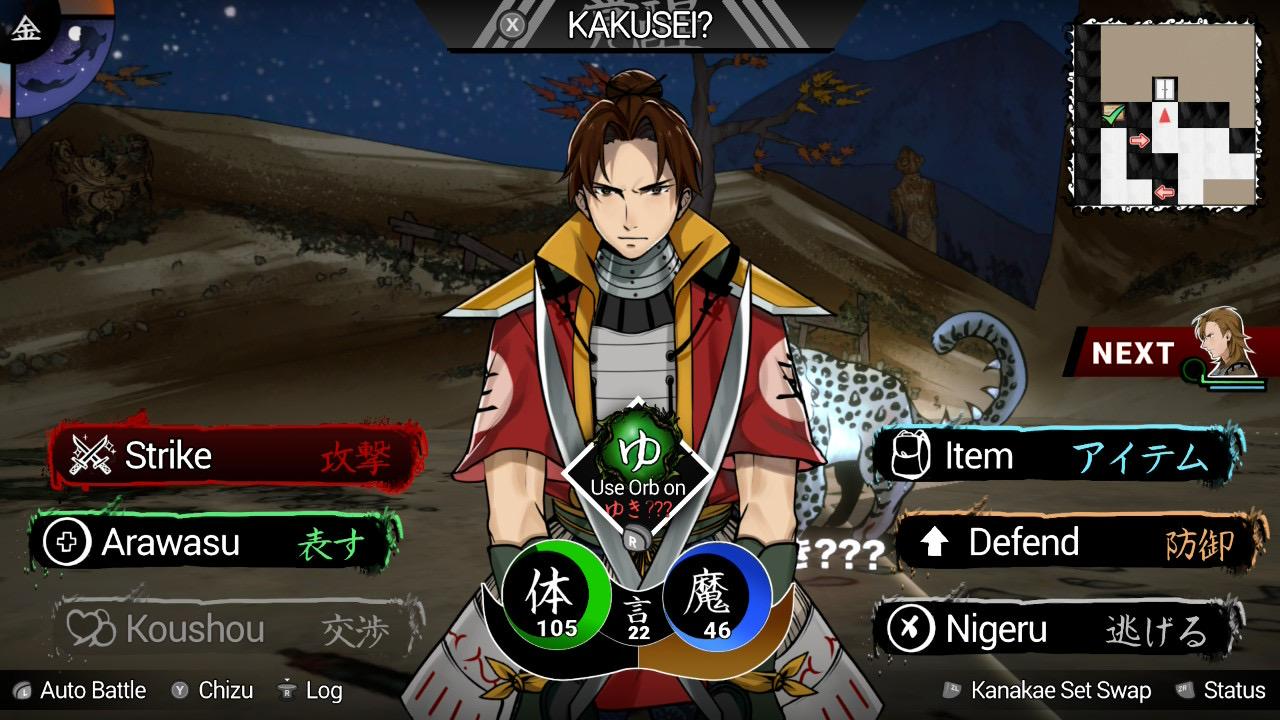
Luckily, the orb system is not the only way to succeed in battle (although it is the most essential). As you exploit elemental and ontological weakness, you'll accumulate Gengoryoku, or language points, which further increase each hero's damage output. Conversely, if your attacks are nullified or reflected, your language points will drop and your overall damage will be reduced. For a while, Gengoryoku isn't all that important. That all changes toward the end of the second labyrinth, when you unlock Arawasu skills. Just as you're feeling like the Kanakae system has reached its limit and lamenting the absence of traditional role-playing spells, buffs, and debuffs, the game answers the call in a big way.
Using Arawasu points (earned by leveling up), Shu and his comrades can learn battle, bonus, and field skills. Battle skills include elemental and recovery-based spells; bonus skills are passive abilities, e.g. critical hit chance up; and field skills are helpful when exploring labyrinths. Pro tip: invest in Shu's field skill “To Surveil” to increase the likelihood of getting the drop on the enemy; you'll thank me later. All these skills add much-needed tactical depth to the battle framework, and allow for many different character builds. The only downside: the skill tree menu is a little clumsy and difficult to navigate.
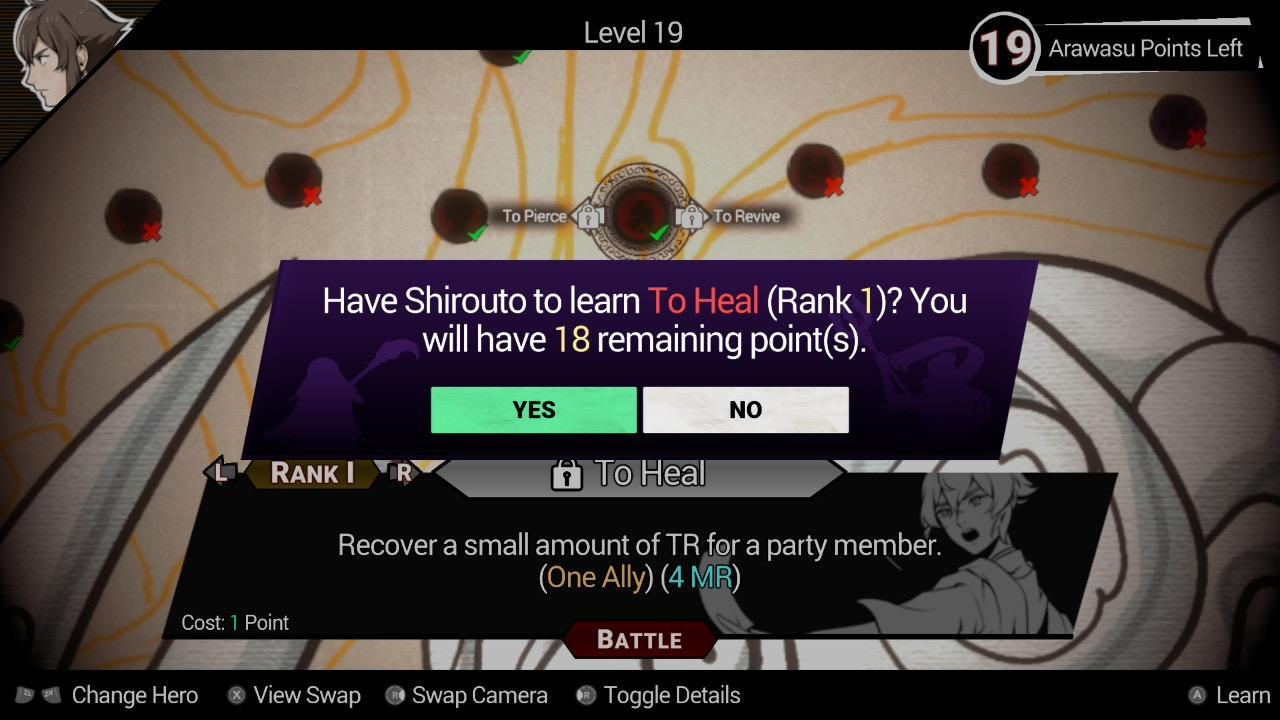
This is a nagging issue throughout Shujinkou, actually. At times, in certain menus, it's challenging to see which row or button is highlighted. I struggled the most in Daisuke's smithy and in a diverting mini-game unlocked after you meet Jin where you use the analog stick or the Switch touchscreen to practice drawing kana. Navigating each town can also be something of a chore.
These instances are very much the exception to the rule, however. In general, Shujinkou is filled with quality-of-life features designed to accommodate even the fussiest and most forgetful players. You can choose from several difficulty settings; alter the speed of battle; elect to share XP with non-party members; and even swap the measurement system from metric to imperial. Moreover, the game will send you a reminder if you haven't saved in a while (this rescued me from my inattentiveness more than once), warn you if a side-quest is about to expire; and make orb combination suggestions before you enter a labyrinth. Finally, there's a super helpful cloud indicator in the bottom right corner of the screen that grows redder and darker as you're about to trigger a random encounter. It's all incredibly considerate.
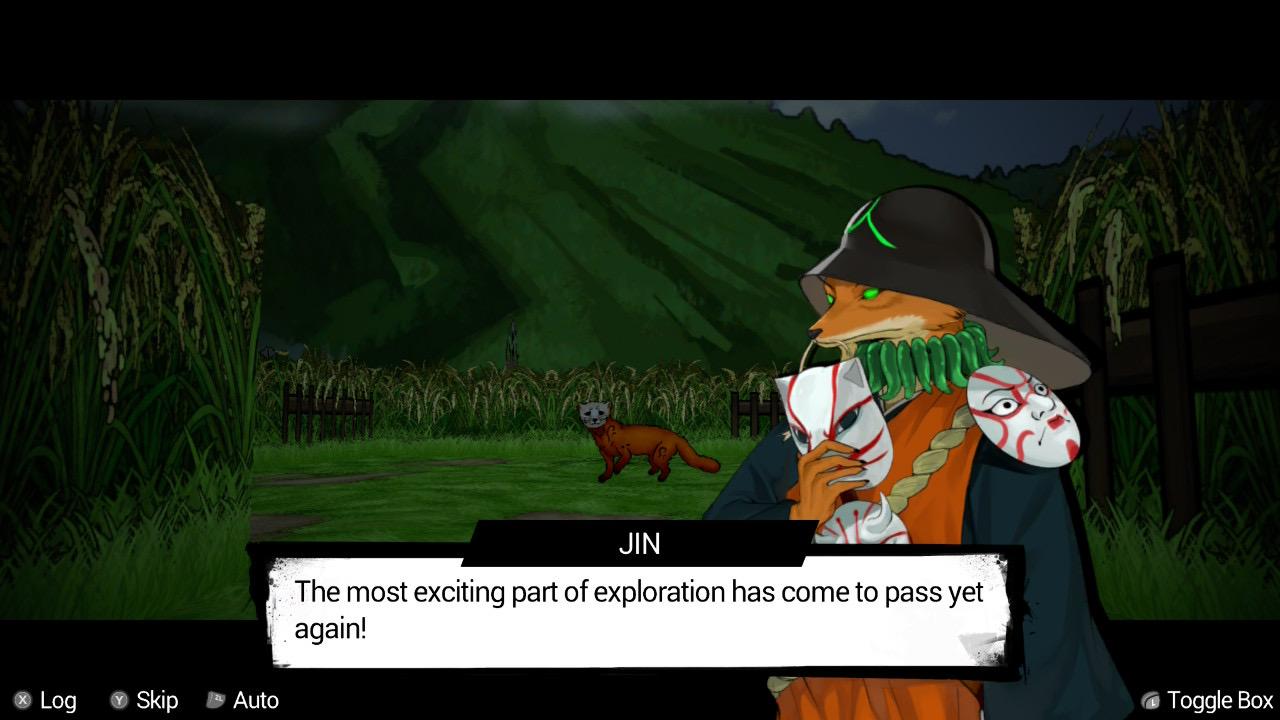
The game is equally considerate when it comes to reducing the burden on those struggling with Japanese or who simply want to minimize the language learning aspect. At the very beginning of the game, Rice asks if you are interested in learning Japanese as you play. I chose “maybe a little”. He also asks what you're most looking forward to: an amazing story, learning Japanese, etc. And he offers an extraordinary suite of customization options to ease players into the adventure. You can set your Japanese level as rookie, amateur, familiar, fluent, or no interest; you can set your emphasis as gamer, learner, or mix; and you can play around with display options, choosing when to read in English, Japanese, romaji, or furigana (small kana characters typically written above kanji to show their pronunciation). And, if you ever get overwhelmed, you can toggle English mode at the press of a button to get your bearings.
Despite all this, though, there are times when the language-learning and role-playing aspects of Shujinkou clash somewhat. This is true of the Kanakae system, mentioned previously, but also the fishing mini-game and several Fuu Lobby parlor games, which can be discouraging if you haven't committed certain characters to memory. When Shujinkou teaches you Japanese syllables, words, and syntax obliquely, it's at its best. When a more thorough understanding is required, it can cause some frustration.
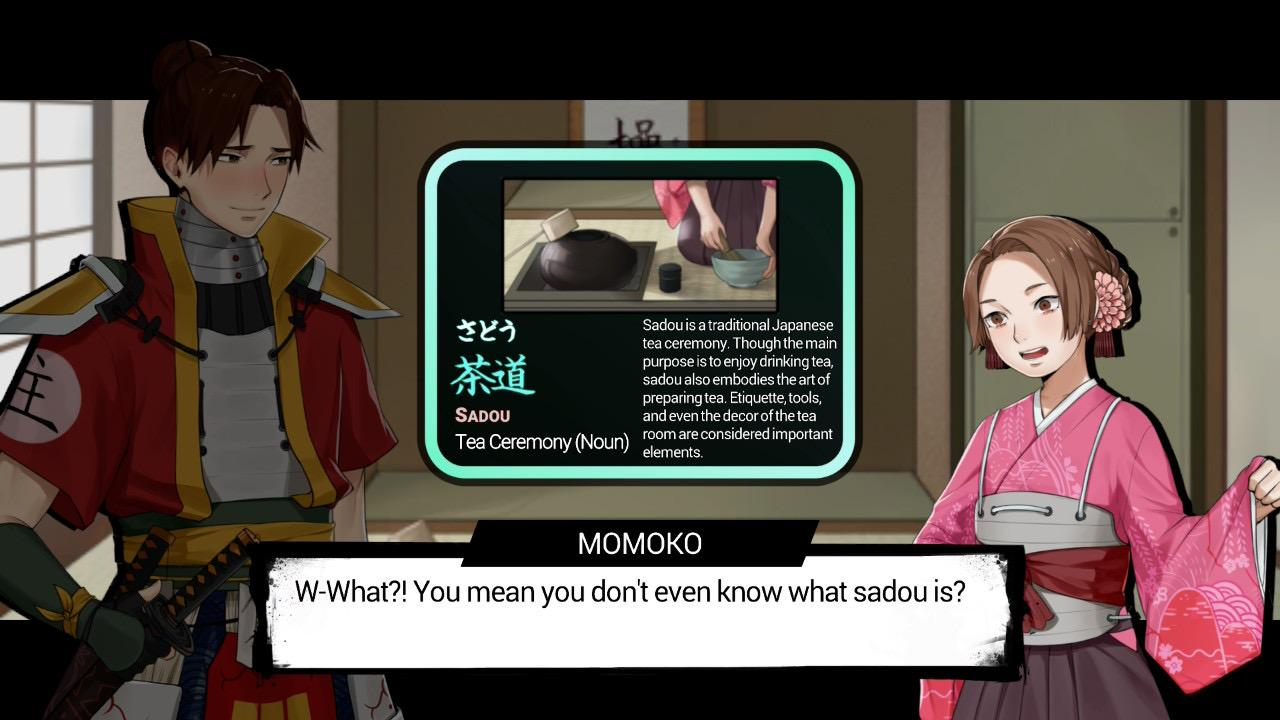
There's nothing frustrating about the game's ancillary content, however. Like any great RPG, Shujinkou offers the player plenty of things to do and achieve outside the main campaign. That includes dozens of side-quests, posted by villagers in need on signboards throughout the land. These cover demon hunting, item collection, and even detective work. And while the quests themselves aren't that unusual, the narrative benefits certainly are. Nothing about the work is impersonal; you don't simply pick a task and then redeem it upon completion. Rather you must engage with the quest-giver before and after, learning something new about them, strengthening your relationship, or maybe even overcoming some prejudice.
In addition to side-quests, you can engage in romantic pursuits with one of six characters. As you resolve their issues, you will unlock new costumes, more personal quips, and special bonuses that can serve you very well in your journey. Develop your relationship with Kiyo past a certain point, for example, and you'll earn a chance to reveal an enemy kana at the start of a battle.
Because of all this optional content, not to mention the lengthy campaign, you can expect to spend at least 40 hours in Genya. One thing to note, for Switch purchasers: unlike the PlayStation and PC editions, which include both of the game's full-length arcs, the Nintendo version was released in two parts — the Genya Arc and the Sabaku Arc, each sold separately or together in a Deluxe Edition. This review covers only the Genya Arc.

No matter the arc, Shujinkou benefits from some lovely artwork. It's not quite as polished as some other RPGs, but considering that Rice essentially developed the game himself (alongside a team of ~20 part-time contractors), it's quite impressive. It benefits from a hand-drawn painterly aesthetic, which looks especially good inside each labyrinth. The enemy designs and up-close character portraits are excellent, as well; Shu and friends manage to carry a lot of emotion upon their faces. Some of the town and city settings lack visual depth, but it's hardly a deal-breaker.
Finally, I want to call attention to a small, but effective thing: the game's use of text. Depending on the conversation and the mood, certain words may be more loopy or exaggerated. In one instance, ahead of a battle with a big oni at the end of Sanrin, the letters hang off the sentence like an old screen door, as if to represent the unhinged nature of the demon. In another, when several characters are drunk, the letters collide with each other.
As for performance, it's solid, at least on Switch 2. I did encounter more loading screens than usual, but they only lasted a few seconds. There was also one strange softlock situation in the fourth dungeon, which required me to quit and load an earlier save.
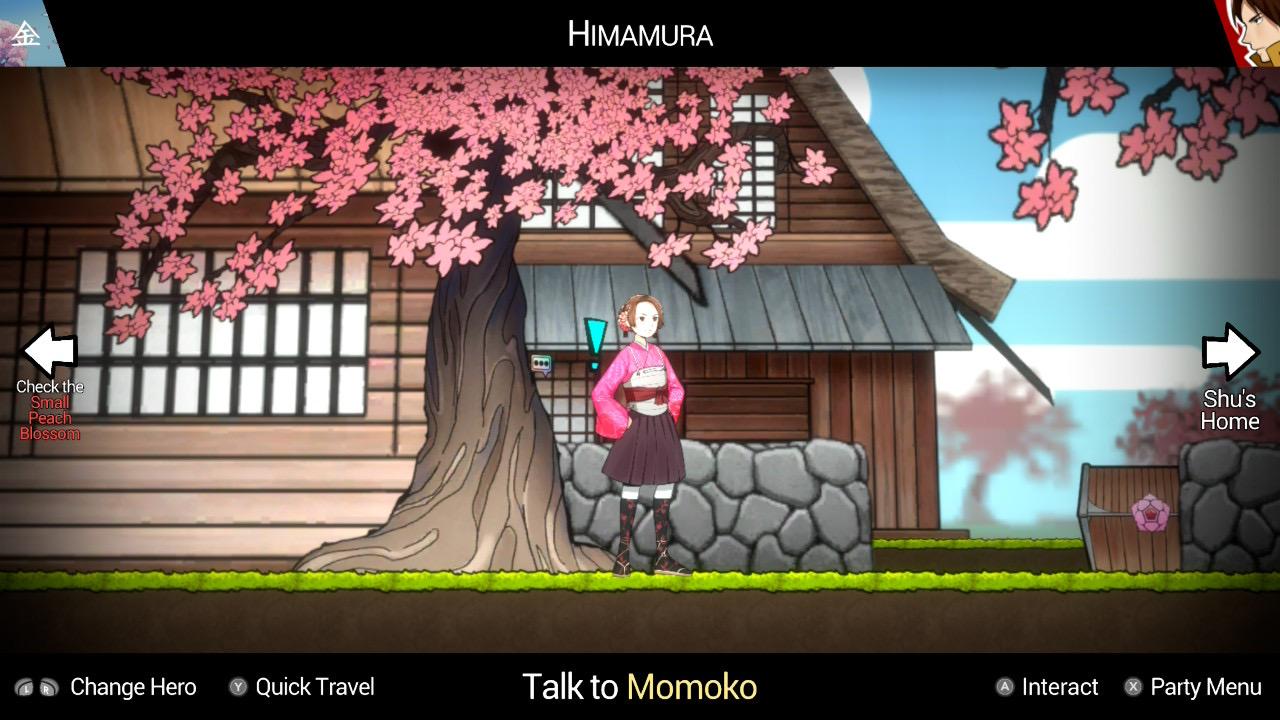
Then there's the game's soundtrack, which is perhaps the most pleasantly surprising piece of Shukinkou. I quickly fell in love with the soundscape of Genya. The main theme, from Brian LaGuardia, is sweeping and nostalgic; the Kouya labyrinth theme from Robert Mullis, with its driving acoustic guitar, is one of the best “desert” themes you'll hear all year; and the Genya Kaikou night music from Ryo Noguchi, with its aggressive sax and playful piano, is an instant classic.
Thanks to Shujinkou, I know more Japanese than ever before. I have a basic understanding of sentence structure and logic, and can call upon a limited vocabulary. More importantly, though, I can say I've played a legitimately great RPG. Thanks to its lovable characters, addictive dungeon-crawling gameplay, meaningful side-quests, great music, and inventive syllable-based fighting mechanics, it's both an outstanding video game and an effective teaching tool. Now, not everything is perfect. Some of the menus are clumsy, the Kanakae system can be overwhelming, and there are rare instances where the language-learning and role-playing aspects fight for control. But, in general, the game accomplishes its very ambitious goals. Julian Rice should be immensely proud of what he's achieved here.
This review is based on a digital copy of Shujinkou for the NS, provided by the publisher.
More Articles








